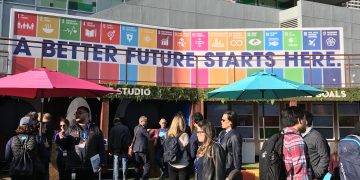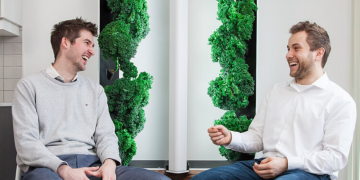7 leaders predict the future of Sustainability
The future of sustainability. We asked 7 sustainability leaders to predict what is coming up in the world of sustainability themes include circular economy, enterprise-wide sustainability, and the rise of ESG reporting.
Sustainability is by definition about the future. It’s about the future of business and society and ultimately about our future as a planet. 2017 saw some of the worst (un)natural catastrophes that the world has ever seen. From floods to fires, our climate is changing like never before. 1500+ scientists recently issued a second notice to humanity- a warning that we’re at a point of no return unless we change our actions. Yet at the same time, we’re faced with climate change deniers and workplaces stuck in the old way of doing things.
The good news is, there are more people than ever before looking to roll up their sleeves to help. With forward-looking leaders recognizing the old ways of doing things only set us back and jeopardize generations to come, sustainability, in our homes and in our workplaces, is becoming a must-do vs. a nice to do.
Although we don’t know what the future has in store, we can get a sense of what’s to come and what is needed to change by speaking to the experts working on sustainability issues every day. I asked seven sustainability practitioners and leaders: “What does the future of sustainability look like: what’s an emerging trend and opportunity you are seeing and how can people and companies prepare?”. Here’s what they said:
Sustainability will become part of the decision-making process for consumers.
– David Berliner, CEO, CoPower
Circular economy and sustainable procurement will create a more sustainable future.
“The circular economy is a business model that has great potential to tackle the critical issues we face today. Its simple theme is to keep resources in use for the longest period of time at their highest value- for example, recycling plastics into the same or higher value use- not park benches or burning for energy. We need to move from a take, make, waste economy to one that keeps going around. One example of this would be HP’s closed-loop process for ink cartridges.
A challenge to the circular economy trend is that as a society, we have typically dissociated businesses stewardship of the product after the customer is done with it. Market pressures today are to drive for cheaper, disposable products. In Canada, very few products out of millions sold, have regulation about disposal after end of life use. This results in Canadians having a huge ecological footprint, in fact if everyone lived like a Canadian, we’d need 5.1 planets to survive. It’s simply not sustainable. The circular economy draws inspiration from nature. Canadians & companies can start by thinking about the footprint of the goods and services they buy and the companies they choose to do business with. Purchasing decisions such as leasing or purchasing a service rather than ownership can have a much lower footprint and incent more durable product design. Requiring that a product is repairable is a simple requirement that can have long-lasting implications.
Sustainable procurement is one of the last bastions of business to get tackled because it’s really hard to do. But on the flip side, purchasing from a company who is already sustainable, is the fastest way to green your business. It’s important to note, that the impact of greening the supply chain is company dependent. Companies need to identify the area of greatest ‘greening’ opportunity for their business. For HP, we can achieve more than 50% our sustainability impact by changing how our customers use our products compared to a 2% impact in our offices that house our 55,000 employees. So companies need to be mindful of focusing on the areas of greatest impact for their specific organization.”
-Frances Edmonds, Head of Sustainability, HP Canada
Sustainability will be integrated enterprise-wide, from job descriptions to performance metrics.
“The future of sustainability is unity. To truly make an impact both on the world and the bottom-line, sustainability needs to be part of everyone’s job description. By hiring passionate, socially-minded people and evaluating CSR performance on the same level as financial and operational metrics, entire sectors will be working toward the same goal, and we will be ten times more powerful as a global community in fostering social betterment and prosperity.”
-Pierre-Francois Thaler, co-CEO of EcoVadis
Responsible investing will be mainstreamed as ESG disclosures become more prevalent.
“Over the past several years, we have increasingly seen responsible investing (RI) embraced by mainstream investors in a meaningful way, with 26% of all professionally managed assets under management globally pegged to RI strategies. At the institutional level, over 1700 asset managers, pension funds and financial service providers are now signatories of the PRI (Principles for Responsible Investing). With sustainability more often a regular part of the investment discourse, investors and companies alike are taking stock. While there is still a long way to go, many companies are improving ESG disclosures and engaging with investors on issues ranging from carbon emissions to human rights. Through September of this year, companies, municipalities and sovereigns have issued almost $90 billion in green, social and sustainability bonds. And, on the investor side of the coin, several firms are now combining big data techniques and machine learning with ESG factors to develop quantitative investment strategies. Looking ahead, we see these new branches of responsible investing bearing fruit. ”
– Bob Mann, President, Sustainalytics.
The need for sustainability will become more apparent and prioritized throughout the entire organization.
“We are the final generation that can solve climate change. It’s a pretty grim thought but Millennials are positive and have a ‘can do’ attitude. It’s not just sustainability practitioners that want to be part of the solutions. Individuals from all backgrounds and expertise are eager to integrate a sustainability mind frame into their work.
As such, companies should not view sustainability as a program in a silo or the responsibility of an individual department. They need to rethink and revolutionize business models to weave sustainability into their business strategy. ”
– Klaudia Watts, Managing Director, Foundation for Environmental Stewardship
The most successful and competitive companies will have a social purpose at their core.
“There is an emerging trend to businesses adopting a social purpose as their reason for being. A social purpose business exists to create a better world. It is an engine for good, creating social benefits by the very act of conducting business – its growth is a positive force in society. Companies, large and small, publicly traded, co-operatives and privately held businesses, in all sectors, are recognizing the imperative of building their social license not just to operate, but to grow. They are responding to trends in which customers prefer to support companies that have a meaningful societal purpose, and abandon brands that don’t. The public sector is stepping up to buy from suppliers that demonstrate societal benefits. Employees prefer to work for companies with a sense of purpose and are more motivated and energized by purpose employers. It is easier to attract suppliers, investors and business partners as collaborators while having a social purpose drives innovation. Companies with a north star social purpose find it helps to align the business and navigate complexity and turbulence.
Businesses can prepare for this trend by identifying the social and environmental mega-forces that will affect its operations, customers, suppliers, business partners and operating context in the future. It can then determine the societal need it addresses through its core business, that it can embed throughout everything it does, and thereby create value for itself, its customers and society overall.
Another route would be to uncover the company’s heritage story, upon which it was founded, which traditionally involved meeting an unmet need. This heritage or legacy story can be updated and enhanced with new insights, thereby helping the company become a force for good, benefiting humanity and improving life for all.”
Coro Strandberg, President, Strandberg Consulting
The rise in informal working and a backlash against the sharing economy will result in new sustainable opportunities.
“One trend I’m seeing right now is the backlash against the sharing economy and the continued uptick in informal working. Whereas several years ago, there was some excitement about being able to rent out someone’s apartment or paying a discounted taxi fare, many of these platforms have become behemoths unto themselves and are running into challenges with accountability and responsibility. This includes customer and worker safety, paying appropriate taxes, and managing a bevy of negative externalities to communities.
I see a number of opportunities for the government to adapt laws for the informal economy and entrepreneurs, for labour unions to modernize and adapt to new employment realities, for “disruptor” companies to take greater responsibility for their impacts, and even for ancillary companies such as benefits and insurance to offer new products and services.”
Heather Mak, Consultant, Deloitte
Want more curated content delivered straight to your inbox?






No Comment